This year the Healthcare Equality Index, a report produced by the Human Rights Campaign that shows which hospitals and health care facilities score best on measures relating to lesbian, gay, bisexual and transgender patients, visitors and employees, is flashing some big numbers:
- A 40 percent increase in the number of health care facilities volunteering to participate in the 24-question survey that makes up the Healthcare Equality Index.
- A 162 percent increase in the number of health care facilities dubbed ‘leaders’ in LGBT heath care equality. Leaders, according to the report, are hospitals and facilities that meet practices and policies they consider to be “essential for equitable and inclusive LGBT care.” That means hospitals and facilities don’t discriminate against LGBT members as patients, visitors or employees.
That’s the good news.
The bad news is that only 407 health care facilities in the U.S. participated in the Healthcare Equality Index, a voluntary survey that’s been around since 2007. It’s a big gain in respondents over previous years, but considering that there are more than 5,700 hospitals in the U.S., there’s still a ways to go. And there are 18 states in the U.S. with no providers that have participated in the HEI.
Health and Human Services Secretary Kathleen Sebelius says while the report shines a light on facilities that are giving great service to the LGBT community there is more to be done. At a press conference at Howard University Hospital on Tuesday, Sebelius announced that HHS released a new progress report on LGBT health care in the U.S.
Last year Sebelius promised to incorporate the LGBT community into federal health care data collection — something the federal government hasn’t done before — and said questions addressed to the LGBT community will be “market-tested” before they will be finalized. This report is expected to address those data collection concerns.
But the secretary says there are still barriers for the LGBT community: “Today LGBT Americans face numerous barriers to health from providers who just don’t understand their unique health needs, to difficulty getting health insurance because they can’t get coverage through a partner or a spouse. And unfortunately way too many LGBT individuals face discrimination and bigotry in the health care system.”
A 2010 report conducted by Lambda Legal, a civil rights group focused on LGBT legal issues, shows that 73 percent of transgender respondents and 29 percent of lesbian gay and bisexual respondents said “they believed they would be treated differently by medical personnel because of their LGBT status.”
This year’s survey asked participating facilities about how and if they give their patients a chance to identify themselves as LGBT. More than 57 percent of participating health care facilities said they allow their patients to note if they are in a “non-state-registered same-sex partnership.” Furthermore, 9 percent of this year’s participants in the HEI noted that they offer a transgender-inclusive health benefit plan — something that is atypical for most U.S. health care plans.
Last year the Centers for Medicare and Medicaid Services began requiring facilities that allow visitation to include same-sex partners and not discriminate against transgendered visitors or patients. Similarly, The Joint Commission, a health care accreditation group, requires that facilities prohibit discrimination based on “sexual orientation, and gender identity or expression.”
“HHS standards and The Joint Commission’s regulations [were among] several factors that contributed to the increase” of responding facilities, said Paul Guequierre,deputy press secretary for the Human Rights Campaign. He says there is always a push to get more health care facilities to participate in the HEI, and this year has been a step in the right direction. “The general awareness of the issues surrounding the health of the LGBT community and an administration that is supportive of LGBT health care equality has helped get more facilities to participate.”
Shane Snowdon, director of health and aging programs at HRC, says the next big step for the index is to expand it to include aging and older LGBT communities.
“This is the first ‘out’ generation and there is a tremendous concern for their health,” she says. HRC plans to incorporate long term care facilities into their index, but that’s just in the beta testing stages for now, Snowden notes.







